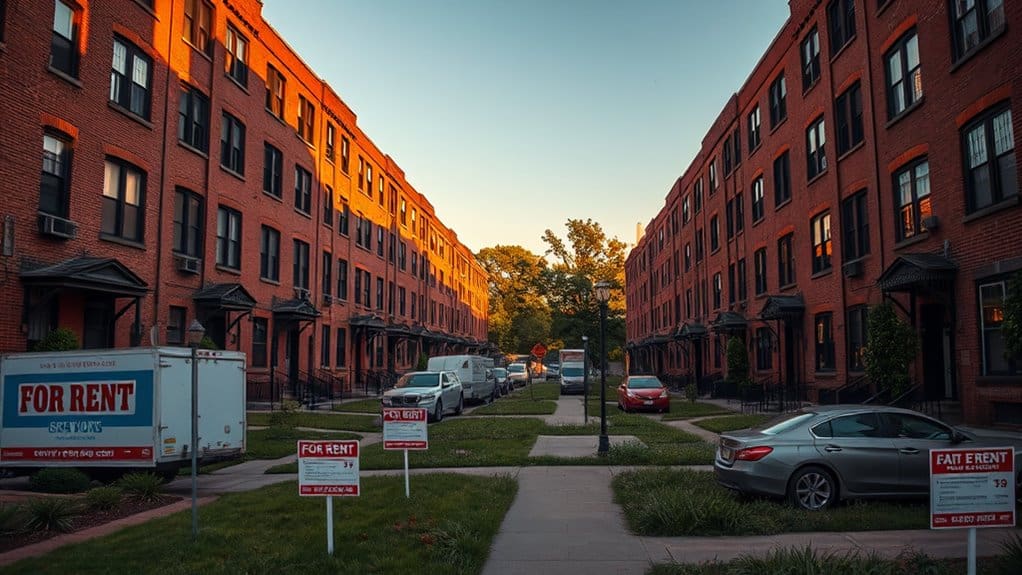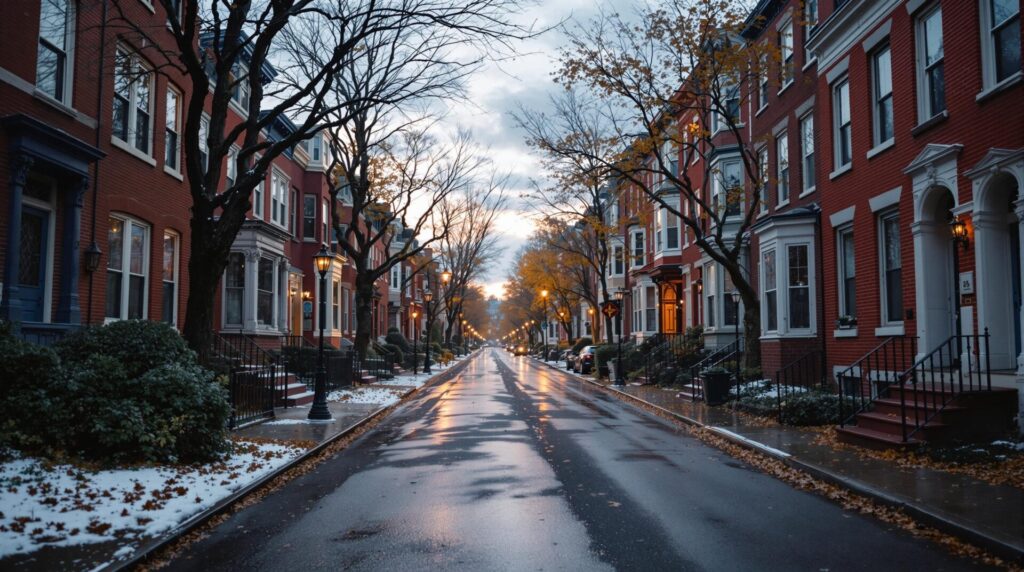Impact of University Populations on Rental Market Stability
When the University of Michigan's enrollment increased by 7% in 2021, Ann Arbor's rental market saw immediate ripple effects across its housing ecosystem. You'll find that university populations don't just influence housing during the academic year – they create year-round stability in rental markets that extends far beyond campus boundaries. While many assume student housing demand fluctuates dramatically between semesters, the reality reveals a more complex pattern that affects everything from property values to local business sustainability. Understanding these dynamics can make the difference between success and failure in university-town real estate investments.
Enrollment Growth Drives Housing Demand
The steady growth of student enrollment at four-year public universities has become a driving force in the rental housing market. You'll find that enrollment demographics at major institutions continue to expand at rates exceeding 1% annually, outpacing general population growth and creating sustained demand for student housing. Public institutions have increasingly turned to private sector partnerships for new dormitory development to meet growing needs. Recent data shows record occupancy rates in Fall 2022 and 2023 before starting to normalize.
What's particularly interesting is that the demand for student housing beds has consistently surpassed enrollment growth for more than a decade at large public universities. This trend is especially pronounced at institutions with Division I athletics and strong research programs, where housing affordability remains a significant concern for students.
While the college-aged population recently experienced a temporary dip, it's projected to grow by 1.1% annually through 2031, maintaining steady pressure on housing markets near major universities.
You'll notice that location plays a vital role, with states like Texas, Nevada, and Washington leading the charge in college-aged population growth. This geographic variation creates unique opportunities in markets where student housing supply hasn't kept pace with demand, particularly around flagship universities that continue to attract growing student populations.
Off-Campus Housing Market Dynamics
Amid unprecedented demand for student housing, off-campus rental markets near major universities continue to experience significant supply shortages and rising costs.
You'll find that student preferences are shifting toward higher-quality accommodations with private spaces and premium amenities, which has contributed to the remarkable 7% year-over-year rent increase to $829 per bedroom.
The market's strength is evident in record-breaking preleasing rates, with nearly 70% of beds already secured for upcoming terms.
Despite economic uncertainties, housing quality remains a top priority for students, and properties near campus command premium prices.
You're looking at a sector that's proven especially resilient, maintaining rent collection rates above 95% even during challenging times like the pandemic.
If you're wondering about market stability, you'll be interested to know that student housing typically operates independently from broader real estate trends.
While the supply of new beds is growing at just 0.8% annually through 2031, steady enrollment growth and strong student preferences for off-campus living continue to drive demand, particularly at tier-one universities where housing shortfalls are most acute.
The room-by-room rental strategy allows property owners to maximize their rental income potential compared to traditional single-unit leasing.
Parent guarantees on rental agreements provide an additional layer of income security for property owners.
Seasonal Rental Patterns
Predictability defines the seasonal rental patterns near universities, where demand ebbs and flows with academic calendars.
You'll notice that student housing remains consistently occupied during fall and spring semesters, creating a reliable pattern you can count on for rental income. The presence of faculty and staff adds stability to the rental market throughout the year. With lease flexibility becoming increasingly important, many property owners now offer 9 or 10-month terms to align with academic schedules. Landlords often generate nearly double income by renting properties by the room rather than as single-family units.
To maximize your property's potential throughout the year, consider these proven strategies:
- Adjust rental pricing seasonally to maintain occupancy during slower periods
- Offer flexible lease terms that accommodate both academic and summer schedules
- Target summer program students and faculty to fill vacancy gaps
- Create incentives for year-round leases to maintain stable occupancy
While you might experience some vacancy during summer and winter breaks, universities with extended academic calendars or summer programs can help maintain steady occupancy rates.
Understanding these patterns helps you develop effective pricing strategies and lease terms that work for both you and your student tenants. By adapting to these predictable cycles, you'll be better positioned to maintain consistent rental income throughout the year.
Local Economic Impact
Universities' economic influence extends far beyond campus boundaries, creating a powerful ripple effect throughout local communities. When you look at student spending patterns, you'll notice their considerable impact on local businesses, from restaurants and retail shops to entertainment venues. This consistent economic activity helps create jobs and generates valuable tax revenue for local governments, strengthening the overall financial health of the area.
You'll find that university populations greatly affect housing markets, particularly in urban centers where demand tends to be highest. Current data indicates rental rates are experiencing a 7.1% year-over-year increase nationwide. A study shows that regulatory barriers typically account for over 40% of multifamily development costs. As student enrollment grows, you can expect to see increased construction and maintenance of residential properties, which creates additional employment opportunities and attracts new investment to the region.
Property values often rise in university towns, though this effect varies by location, with Northeast regions typically experiencing higher rent increases than other areas.
If you're considering investing in university-adjacent properties, you'll want to pay attention to regional demographic trends and enrollment patterns, as these factors directly influence rental market stability and potential returns on investment.
Investment Opportunities and Risk Factors
When looking at student housing investments, you'll find remarkable stability even during economic downturns. The market's resilience is evident through consistent demand, predictable tenant pools, and strong rent growth, making it an attractive option for property investors.
You'll benefit from higher rental yields compared to traditional residential properties, especially when renting by the room.
The investment benefits of student housing are particularly compelling when you consider these key advantages:
- Parent-guaranteed leases that enhance rental income reliability
- Steady annual demand cycles tied to academic calendars
- Dynamic pricing that serves as an effective inflation hedge
- Higher rental yields through individual room leasing strategies
However, you'll need to carefully evaluate potential risks before diving in. Market saturation in popular college towns can create fierce competition, and enrollment volatility poses a significant concern.
You'll want to focus on properties near tier-one universities with strong enrollment trends and housing shortfalls. Keep in mind that while online learning and international student policies can impact demand, the overall outlook remains positive with projected growth from 8.5 million beds in 2020 to 9.2 million by 2031.
Frequently Asked Questions
How Do Summer Sublease Rates Compare to Regular Academic Year Rental Prices?
You'll find summer pricing typically runs 20-30% lower than academic year rates, as rental trends show decreased student demand and increased competition among sublessors during summer months.
What Percentage of International Students Choose University Housing Versus Private Rentals?
You won't find exact percentages for international housing preferences, as detailed data isn't available. Student rental trends suggest choices vary by location, budget, and individual needs when selecting university or private housing.
Do Universities' Online Learning Programs Affect Local Rental Market Occupancy Rates?
Despite 2022's record-breaking student housing performance, you'll find online enrollment trends have minimal impact on rental occupancy rates, as remote learning effects haven't substantially altered the strong demand for campus-area housing.
How Do Campus Transportation Services Influence Rental Prices in Surrounding Neighborhoods?
You'll find higher rental prices in areas with strong campus accessibility, as students prioritize convenient transportation. When you're near campus shuttles or transit hubs, reduced transportation costs drive up housing demand.
What Impact Do University Research Grants Have on Graduate Student Housing Choices?
You'll find research funding indirectly shapes your housing choices by boosting stipends and attracting more students, while housing accessibility near campus depends on available grants and local market conditions.
Conclusion
Final Thoughts: Seize the Opportunity in University Rental Markets
University populations truly anchor rental market stability.
Think of them as a lighthouse guiding investors to safe shores.
With predictable enrollment patterns, demand remains steady year-round.
Seasonal peaks provide opportunities you can set your watch to.
These markets offer unique investment avenues ripe for exploration.
Takeaway: Consider the local regulations and property maintenance.
University rental markets stand out as a reliable investment choice.
Call to Action: Dive into these thriving markets and unlock dependable returns.
Explore, invest, and let the steady stream of university demand work for you.





















